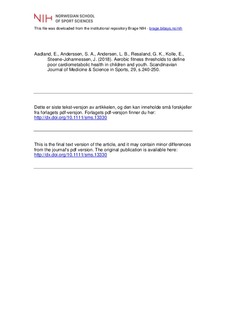| dc.contributor.author | Aadland, Eivind | |
| dc.contributor.author | Anderssen, Sigmund Alfred | |
| dc.contributor.author | Andersen, Lars Bo | |
| dc.contributor.author | Resaland, Geir Kåre | |
| dc.contributor.author | Kolle, Elin | |
| dc.contributor.author | Steene-Johannessen, Jostein | |
| dc.date.accessioned | 2019-11-21T14:24:42Z | |
| dc.date.available | 2019-11-21T14:24:42Z | |
| dc.date.created | 2018-11-10T12:00:05Z | |
| dc.date.issued | 2019 | |
| dc.identifier.citation | Scandinavian Journal of Medicine & Science in Sports. 2019, 29, 240-250. | nb_NO |
| dc.identifier.issn | 0905-7188 | |
| dc.identifier.uri | http://hdl.handle.net/11250/2629887 | |
| dc.description | I Brage finner du siste tekst-versjon av artikkelen, og den kan inneholde ubetydelige forskjeller fra forlagets pdf-versjon. Forlagets pdf-versjon finner du på wiley.com / In Brage you'll find the final text version of the article, and it may contain insignificant differences from the journal's pdf version. The definitive version is available at wiley.com | nb_NO |
| dc.description.abstract | Aerobic fitness is an apparent candidate for screening children and youth for poor cardiometabolic health and future risk of cardiovascular disease (CVD). Yet, age‐ and sex‐specific cut points for children and youth determined using a maximal protocol and directly measured peak oxygen consumption (VO2peak) does not exist. We used a nationally representative sample of 1462 Norwegian children and youth (788 boys and 674 girls aged 8.7–10.4 years and 14.7–16.7 years) who in 2005–2006 performed a maximal cycle ergometer test with direct measurement of VO2peak, along with measurement of several other risk factors for CVD (systolic blood pressure, waist circumference:height ratio, total:high density lipoprotein cholesterol ratio, triglycerides, Homeostasis Model Assessment for Insulin Resistance). Based on the proportion of children having clustering (least favorable quartile) of 6 (1.6%), ≥ 5 (5.2%), and ≥ 4 (10.6%) CVD risk factors, we established the 2nd, 5th, and 10th percentile cut points for VO2peak (ml/kg/min) for children and youth aged 8–18 years. Classification accuracy was determined using the Kappa coefficient (k), sensitivity and specificity. For boys, the 2nd, 5th, and 10th percentile VO2peak cut points were 33.6–36.4, 36.3–39.8, and 38.7–43.0 ml/kg/min, respectively. For girls, the corresponding cut points were 29.7–29.1, 32.4–31.4, and 34.8–33.5 ml/kg/min, respectively. Together with BMI, but without more invasive measures of traditional risk factors for CVD, these cut points can be used to screen schoolchildren for poor cardiometabolic health with moderate discriminating ability (k ≤ 0.53). | nb_NO |
| dc.language.iso | eng | nb_NO |
| dc.subject | cardiovascular disease | nb_NO |
| dc.subject | maximal oxygen consumption | nb_NO |
| dc.subject | prevention | nb_NO |
| dc.subject | schoolchildren | nb_NO |
| dc.subject | screening | nb_NO |
| dc.title | Aerobic fitness thresholds to define poor cardiometabolic health in children and youth | nb_NO |
| dc.type | Journal article | nb_NO |
| dc.type | Peer reviewed | nb_NO |
| dc.description.version | publishedVersion | nb_NO |
| dc.source.pagenumber | 240-250 | nb_NO |
| dc.source.volume | 29 | nb_NO |
| dc.source.journal | Scandinavian Journal of Medicine & Science in Sports | nb_NO |
| dc.identifier.doi | 10.1111/sms.13330 | |
| dc.identifier.cristin | 1628929 | |
| dc.description.localcode | Seksjon for idrettsmedisinske fag / Department of Sports Medicine | nb_NO |
| cristin.unitcode | 150,34,0,0 | |
| cristin.unitname | Seksjon for idrettsmedisinske fag | |
| cristin.ispublished | true | |
| cristin.fulltext | postprint | |
| cristin.fulltext | original | |
| cristin.qualitycode | 2 | |
